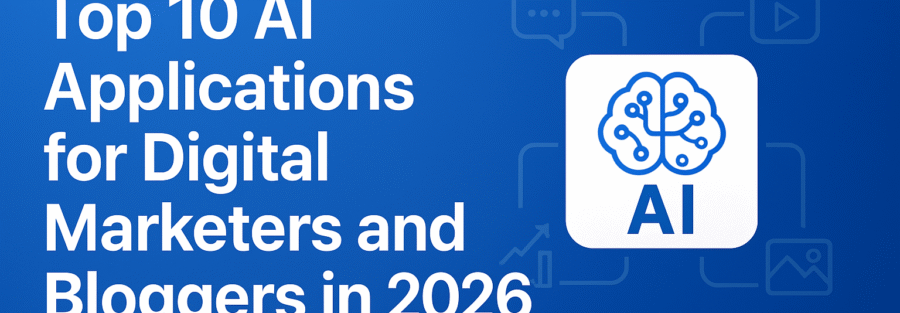Artificial Intelligence (AI) is no longer just a futuristic concept—it has become an essential part of digital marketing and content creation. From automating repetitive tasks to generating personalized content and analyzing campaign performance, AI applications have transformed the way marketers work.
For bloggers and digital marketers alike, leveraging the right AI tools can save time, improve accuracy, and drive better results. In this article, we will explore ten of the best AI applications that can help streamline digital marketing workflows, enhance content strategies, and deliver measurable business impact.
1. ChatGPT (OpenAI)
Purpose: Conversational AI for content creation, brainstorming, and customer interaction.
ChatGPT has quickly become one of the most popular AI applications for digital marketers and content creators. It assists with drafting blog posts, email campaigns, social media captions, FAQs, and more. By simulating natural conversation, it also powers chatbots and customer support systems.
How it helps marketers:
- Reduces writer’s block by generating fresh ideas.
- Speeds up content drafting and editing.
- Provides quick answers for research and brainstorming.
Best practice tip: Always fact-check outputs and refine prompts for specific tone, audience, and purpose. ChatGPT is best used as a collaborator, not a replacement for human creativity.
2. Jasper AIPurpose: AI-powered copywriting and long-form content creation.
Jasper AI is specifically designed for marketers who need scalable content solutions. With customizable templates, it can generate blogs, ad copy, website text, and even scripts. Its ability to maintain brand tone makes it especially useful for agencies and teams.
How it helps marketers:
- Speeds up long-form content creation.
- Ensures consistency across different platforms.
- Supports multiple content formats (blogs, ads, product descriptions).
Best practice tip: Use Jasper’s SEO integration to align content with search engine requirements, ensuring visibility in competitive markets.
3. Semrush
Purpose: SEO and digital marketing analytics.
Semrush is a comprehensive SEO and marketing platform that leverages AI to analyze keywords, backlinks, and competitor strategies. It helps marketers identify opportunities for growth and refine content strategies.
How it helps marketers:
- Conducts keyword research and clustering.
- Performs detailed site audits for SEO improvement.
- Provides competitor analysis and market insights.
Best practice tip: Use Semrush not only for new campaigns but also to refresh older content and regain rankings.
4. Grammarly & GrammarlyGO
Purpose: AI-driven writing assistant.
Clarity, correctness, and professionalism are vital for any content strategy. Grammarly ensures that content is polished, error-free, and aligned with the intended tone. With GrammarlyGO, users can rephrase sentences, adapt tone, and accelerate content drafting.
How it helps marketers:
- Improves grammar, spelling, and readability.
- Enhances brand voice consistency.
- Prevents mistakes that could harm credibility.
Best practice tip: Set up style preferences in advance to ensure Grammarly suggestions align with your brand guidelines.
5. Copy.ai
Purpose: Short-form AI copywriting for ads and social media.
Copy.ai specializes in generating high-quality marketing copy in seconds. It is ideal for ad campaigns, email subject lines, and product descriptions—formats where creativity and brevity are crucial.
How it helps marketers:
- Produces multiple variations of copy for A/B testing.
- Generates engaging captions and taglines.
- Saves time in campaign brainstorming.
Best practice tip: Use AI-generated copy as a foundation, then refine for brand-specific nuance and accuracy.
6. Synthesia
Purpose: AI-powered video content creation.
Video content continues to dominate online platforms, but producing high-quality video can be resource-intensive. Synthesia solves this by allowing marketers to turn written scripts into professional videos with AI avatars and voiceovers.
How it helps marketers:
- Converts blogs into explainer videos.
- Saves time and cost compared to traditional video production.
- Makes video marketing accessible for small teams.
Best practice tip: Keep videos concise and optimized for mobile platforms, as most users consume content on smartphones.
7. Pictory
Purpose: Automated video summarization and repurposing.
Pictory enables marketers to repurpose blog posts, webinars, and articles into engaging video snippets. It automatically highlights key points and pairs them with visuals and voiceovers, ideal for social media promotion.
How it helps marketers:
- Extends the reach of long-form content.
- Enhances engagement on platforms where video performs better than text.
- Simplifies video creation for non-experts.
Best practice tip: Use branded templates to ensure visual consistency across all video outputs.
8. Canva (Magic Studio & AI Features)
Purpose: AI-assisted graphic design and content creation.
Canva has long been a favorite among marketers, and with its AI-powered Magic Studio, it now offers smart design suggestions, AI-generated images, and automatic resizing for different platforms.
How it helps marketers:
- Empowers non-designers to create professional visuals.
- Provides quick, ready-to-publish templates for social media and blogs.
- Reduces dependency on external graphic design resources.
Best practice tip: Create a brand kit in Canva (fonts, colors, logos) to ensure every design is aligned with your identity.
9. BrightEdge
Purpose: AI-driven content strategy and optimization.
BrightEdge uses AI to analyze search behavior and predict which topics will drive engagement. It offers actionable insights for optimizing content strategies and improving audience targeting.
How it helps marketers:
- Identifies high-performing keywords and content gaps.
- Provides recommendations for optimizing existing content.
- Helps prioritize content based on potential ROI.
Best practice tip: Combine BrightEdge insights with editorial calendars to ensure consistent, data-driven publishing.
10. Ocoya
Purpose: AI-powered social media content generation and scheduling.
Ocoya integrates AI copywriting with social media automation, enabling marketers to generate posts, captions, and hashtags while scheduling them across multiple platforms.
How it helps marketers:
- Saves time on post creation and publishing.
- Ensures optimal posting times for engagement.
- Provides analytics to measure performance.
Best practice tip: Use Ocoya for both content creation and scheduling, but monitor analytics closely to refine future campaigns.
The rapid evolution of AI has provided digital marketers and bloggers with powerful tools to enhance productivity and creativity. Whether it is generating engaging content, optimizing for SEO, producing videos, or managing social media, these applications streamline workflows and improve outcomes.
By combining creativity with AI-driven efficiency, marketers can focus on strategy, storytelling, and building stronger connections with their audiences. The key is to treat AI as a partner—one that accelerates growth while leaving room for human expertise and creativity.




